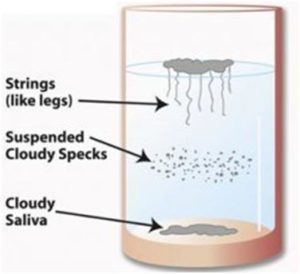
Candida is a yeast or fungus that naturally grows in certain parts of the body. There are over 20 species of Candida yeasts that can cause infection in humans, the most common of which is Candida albicans.
More than 70% of healthy people naturally have Candida albicans living inside their body. Candida feeds on by-products found within the body, like dead tissue and sugar from the diet.
In healthy people, Candida normally resides in the gastrointestinal tract. Small amounts of the yeast also live in various warm, moist areas throughout the body, including the mucous membranes of the mouth, rectum, vagina, and parts of your skin without causing infections.
When your inner ecosystem is in balance, a large number of good bacteria and yeast are thriving together. However, they do compete with Candida and other opportunistic microbes for food and space to grow. When your inner ecosystem is in balance, the mucosa of the gut wall is sealed and healthy. As a result, Candida overgrowth is kept in check.
However, when your inner ecosystem is out of balance, Candida has an opportunity to rapidly grow and take over its environment.
Candidiasis (or fungal infection) that develops in the mouth or throat is called ‘oral thrush’. Candidiasis in the vagina is commonly referred to as a ‘yeast infection’.
Opportunistic Candida is like an aggressive weed, shooting ‘runners’ or ‘tentacles’ of itself through tissue, making it especially invasive. The tentacles burrow into the mucosa lining of the gut to cause chronic inflammation. Over time, this burrowing coupled with unchecked inflammation makes a healthy gut ‘leaky’ and permeable.
A leaky gut is definitely a problem no doubt. A sealed gut lining is meant to protect the body from outside chemicals, bacteria, parasites, and food irritants. When the gut lining is leaky, it no longer protects the body and such products can enter the bloodstream. This creates extra work for both your liver and your immune system.
Once the gut is leaky, Candida has the opportunity to proliferate and spread beyond the gut. Invasive or systemic candidiasis occurs when Candida species enter the bloodstream and spread throughout the body, affecting every tissue it comes across.
Signs of systemic Candida overgrowth range from digestive troubles to migraines, skin disorders like acne and eczema, stiff joints, and brain fog. Because of the vague nature of these symptoms, they are often misdiagnosed, ignored, or easily confused for other health disorders.
Sometimes, Candida yeast may not be the direct cause of a major health problem, yet it is important not to rule it out as one possible cause contributing to poor health.
WHAT CAUSES CANDIDA OVERGROWTH?
Opportunistic bacteria and yeasts like Candida albicans don’t just spontaneously ‘take over’.
There is always a reason why this happens. The three main categories follow:
- POOR DIET
A diet high in sugar, starch, and processed foods is fuel for the yeast to thrive and multiply. The biofilm which coats and protects Candida is made up of 32% glucose. Candida needs sugar not just to reproduce, but also to create the protection in the form of a biofilm that keeps our immune system from attacking it.
- STRESSFUL LIFESTYLE
Stress can lower immunity and therefore lead to a decrease in beneficial gut flora. Remember 70% of immunity is located in the gut. Keeping bacteria in check is crucial to keeping symptoms and sickness at bay. Other factors that can lead to yeast overgrowth is exposure to chlorinated water, alcohol abuse, and digestive distress coming from a lack of stomach acid (hydrochloric acid) which causes undigested food to putrefy in the gut, leading to symptoms such as constipation and diarrhoea.
- PHARMACEUTICAL DRUGS
Antibiotics and the oral contraceptive pill are a huge factor in Candida and yeast overgrowth. These pharmaceuticals eliminate beneficial flora creating the ideal environment which allows for harmful pathogens to overgrow.
HOW TO TELL IF YOU HAVE CANDIDA OVERGROWTH?
You can find out if you have Candida by taking a simple home test.
THE SPIT TEST
If you have Candida overgrowth, it will show up in the saliva, a friendly environment for yeast. Candida concentrates in saliva overnight, so this test is the most accurate first thing in the morning. Do this test before you put anything in your mouth.
Gather some saliva in your mouth and spit into a glass of water (be sure to spit out saliva, not mucus). Keep an eye on the water for about half an hour, but especially in the first few minutes. If you have Candida overgrowth, you will see one or more of the following:
- Strings (legs) hanging down from the saliva
- Cloudy specks suspended in the water
- Heavy-looking saliva at the bottom of the glass

If within three minutes after spitting into the water, you see ‘strings’ hanging down, cloudy specks showing up in the water, or ‘debris’ sinking to the bottom, you most likely have an extensive overgrowth, which will require extensive Candida-fighting action on your part. The more you see, and the faster you see it, the more systemic the infection.
If it takes longer than a few minutes for anything to show up, the Candida is not as serious.
If the saliva just floats on top and the water stays perfectly clear, you most likely don’t have Candida overgrowth.
TREATING CANDIDA INFECTIONS
Treating Candidiasis is by no means a simple process.
As the Candida cells are killed, a ‘Die-Off’ occurs and metabolic by-products are released into the body. Die-Off is shorthand for a Herxheimer reaction. This term was coined to describe what Karl Herxheimer saw when he administrated drugs to his patients. The reaction is thought to happen when toxins from dying pathogens (viruses, bacteria, parasites, fungi such as Candida, etc.) overwhelm the body’s abilities to clear them out.
The changes that might cause Die-Off are usually:
- Switching from processed food to a real food diet (death of pathogens by starving)
- Starting or increasing probiotic dosage (death of pathogens by excess good microbes)
- Starting or increasing dosage of anti-parasitic, anti-yeast or antibiotic (death of pathogens by ‘bombing’)
In each of these scenarios, the treatment will cause substantial changes in gut flora and knock out a big portion of the bad guys. When that happens, they release toxins that need to be excreted by the body.
Candida Die-Off symptoms will vary from person to person, as each will have different degrees of infestation. If you experience severe Die-Off symptoms, it’s important to slow down the relevant treatment and reduce the dosage of probiotics.
The liver is your main pathway for eliminating toxins, and the Die-Off symptoms mean that it is being overwhelmed.
The Candida yeast cells actually release up to 79 different toxins when they die, including acetaldehyde and gliotoxin.
CANDIDA TOXINS RELEASED
- ACETALDEHYDE
One of the pollutants that Candida produces is called acetaldehyde. Acetaldehyde is a metabolic by-product – similar to the carbon dioxide that you exhale after inhaling oxygen.
Too much acetaldehyde is the equivalent of alcohol poisoning. Not surprisingly, it also been found to increase the risk of alcohol-related cancers.
Acetaldehyde, in particular, has a whole host of detrimental effects on your health and well-being. It can impair your brain function and even kill brain cells. There is evidence that the toxin acetaldehyde is associated with Alzheimer’s disease.
Your endocrine, immune and respiratory systems can all be affected, and it also damages the membranes of your red blood cells, reducing their ability to carry oxygen around the body.
Allergic reactions and inflammation also develop leading to an array of undesirable symptoms.
Studies show that a build-up of acetaldehyde can also lead to oxidative stress, damaging the DNA in cells.
- GLIOTOXIN
Candida and other species of fungus make a poison called gliotoxin. Gliotoxin stimulates the death of cells and the destruction of tissue.
In particular, gliotoxin stimulates the destruction of cells in the liver – your number one detox organ. Gliotoxin also suppresses the immune system and kills cells that belong to the immune system.
Both your liver and your immune system play a pivotal role in the protection and detoxification of the body.
Gliotoxin is especially high in patients with multiple sclerosis, an autoimmune disease that affects aspects of the central nervous system, like the brain.
As Candida grows stronger and proliferates, it becomes more poisonous than ever, releasing even more gliotoxin.
Studies have found that yeasts can form a biofilm (a protective matrix) around themselves. Biofilm layers essentially increase the production of gliotoxin by protecting the Candida as it grows.
CANDIDA DIE-OFF SYMPTOMS
The Die-Off symptoms are often reported by many to feel very flu-like or cold-like. Your whole body is generally sluggish and it usually feels as if your body is working harder – almost fighting something.
Die-off usually lasts 3-7 days for most people.
Here is a list of some of the symptoms you might experience during Candida Die-Off
- Runny nose, sinusitis & excess mucous production
- Skin rashes, acne & eczema
- Headache, fatigue, dizziness
- Brain fog
- Swollen glands
- Increased GI problems – bloating, gas, constipation or diarrhoea
- Increased joint or muscle aches/pain
- Elevated heart rate
- Chills, cold feeling in your extremities
- Body itchiness, hives or rashes
- Sweating
- Fever
- Nausea
- Recurring vaginal & prostate infections
HOW TO CLEAR CANDIDA
1. USE ANTI-FUNGALS
Common herbal anti-fungals used in yeast overgrowth treatment include nigella, oregano oil, black walnut, uva ursi, berberine, thyme, and olive leaf as some common options, but these alone won’t do the trick. To properly get to and kill the microorganism that is causing the trouble, you first have to break down the biofilm that’s protecting it.
Anti-fungals need to be paired with a biofilm disruptor, which is a combination of specific enzymes that are designed to eat their way through the matrix.
2. BREAK DOWN THE BIOFILM LAYER
- Enzymes
Candida and other types of yeasts are not able to build a resistance to enzymes like they may be able to do with drugs or herbs. There are no side effects, only side benefits with these enzymes as a type of biofilm disruptor.
When looking for an enzyme formula make sure and find one that contains a varied number of enzymes to target the layer of the cell wall, biofilm, nucleus, and fibrin.
Enzymes to look for include cellulase, glucoamylase, amylase, invertase, protease, and serrapeptase.
- N-Acetyl Cysteine (NAC)
Another agent that is effective as a biofilm disruptor is NAC. This amino acid is a strong antioxidant with antibacterial properties also.
NAC also converts to glutathione in the body, assisting to replenish intracellular glutathione (vital for effective liver detox – see below).
3. SUPPORT YOUR DETOX PATHWAYS
Fortunately, a few shifts in your diet can help your body to detoxify the poisons that Candida produces.
Fermented vegetables and probiotics also inoculate the gut with beneficial bacteria. Beneficial bacteria soothe inflammation (or leakiness) and compete with Candida for nutrients.
Research shows that lactic acid – produced by good bacteria – inhibits the growth of Candida. Cutting sugar out and reducing your carbohydrate intake in your diet is critical if you want to keep Candida contained.
Cruciferous vegetables, such as cabbage, cauliflower, and broccoli, help the body to make glutathione. Because the liver relies on a steady supply of glutathione, it also plays a critical role in the detoxification process. When levels of glutathione are low, detoxification slows down, and the liver becomes congested and toxic.
Glutathione is vital to detoxifying acetaldehyde from tissues.
It is also a powerful antioxidant, protecting the body from the harmful effects of oxidative stress.
LIMITING CANDIDA DIE-OFF SYMPTOMS
Candida Die-off symptoms normally clear up within a week or so, but they could last a little longer. However, there are a few things you can do to slow down this reaction or expel the toxins faster.
- Take a supplement containing activated charcoal to help absorb and expel the toxins from candida die-off.
- Magnesium supplements can also be used to reduce the effects of Candida Die-Off especially due to acetaldehyde. Magnesium deficiency is common under stress and results in a weakened immune system.
- Cut back or temporarily discontinue antifungal supplements.
Antifungals work by breaking down the walls of the Candida yeast cells, which then release the many toxins that the Candida has been producing. Reducing your antifungal dosage will cut down the number of toxins being released into your bloodstream. When you feel better, you can start to increase it again. - Reduce your dosage of probiotics.
A course of good probiotics will re-populate your gut, crowd out the Candida, restore your stomach acidity and boost your immune system. Probiotics are less likely than anti-fungals to cause Die-Off, but if you start to experience the symptoms you can temporarily reduce your dosage. - Increase water intake to flush out the toxins faster.
If you want to feel better, all those by-products that are released by the Candida yeast need to leave your body. You can give them a push by drinking more water. - Rest as much as possible.
Stress can weaken your adrenals and reduce your body’s ability to fight pathogens like a fungal infection. Relaxing and taking some personal time will help your immune system to do what it was designed to do.
WANT HELP?
I would strongly suggest working with a holistic health care practitioner like myself who has experience treating yeast overgrowth to get an effective treatment plan.
An anti-Candida type diet alone can be difficult and usually not enough. You have to get the support to address the cause effectively otherwise you may not get the results you’re after, and you may also experience symptoms even more troubling than the Candida itself.
**If you’ve got this far – thank you for reading and I look forward to bringing you more information in the future.
